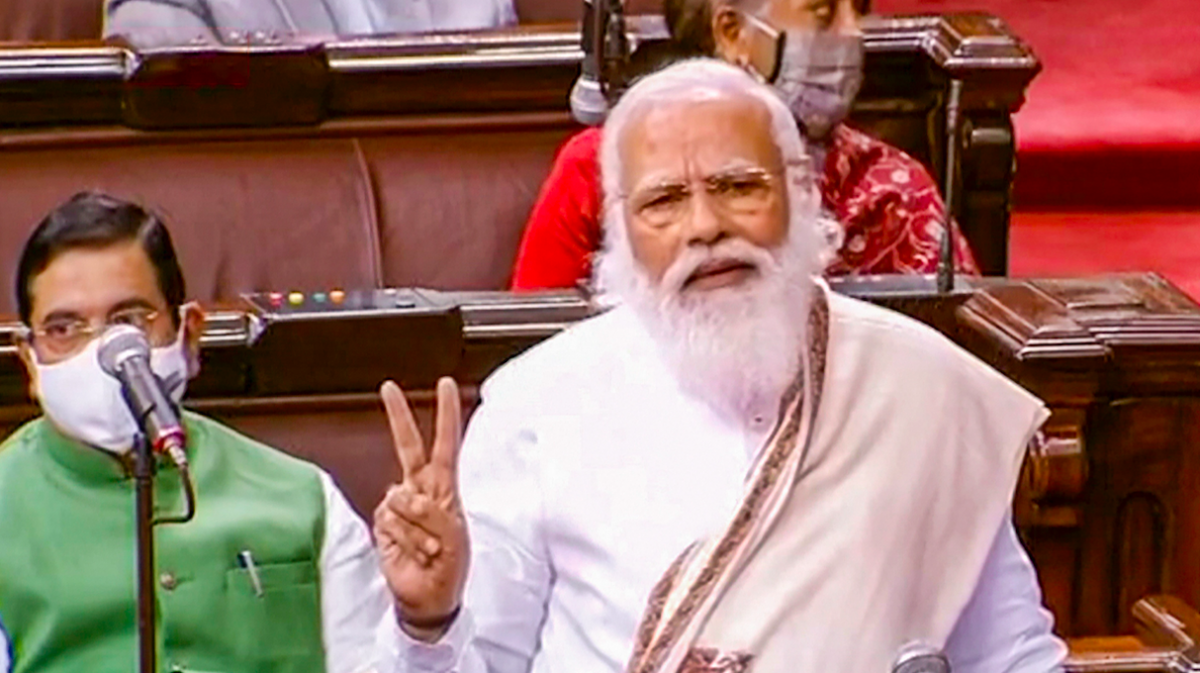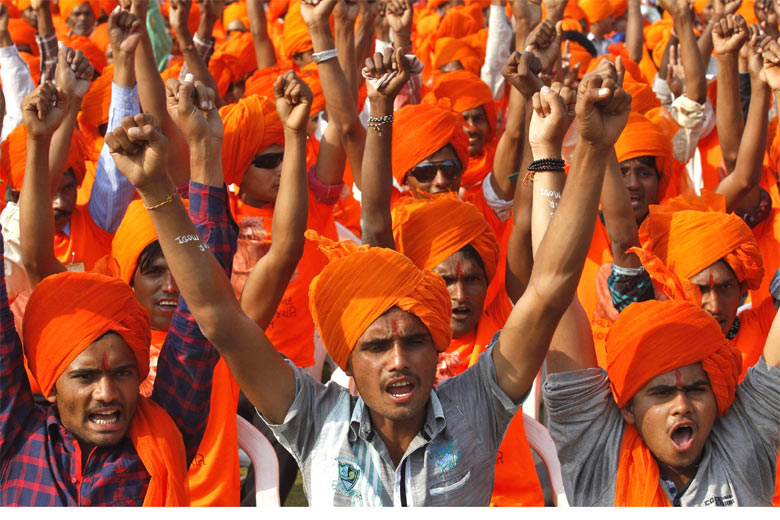Why Shudra Farmers Are Indeed 'Andolanjeevis'
The first Other Backward Class (OBC) Prime Minister of India, Narendra Modi, said in parliament recently that it was important "to identify andolanjeevis and protect the nation from them". He was essentially referring to farmers, the only social force in India that produces food for all Indians, who have been protesting against the new farm laws.
The concept of andolan has two meanings: the first one refers to ‘worry’, and the second represents 'protest or agitation'. In Telugu, it is mostly used as a word to describe 'worries'. If they say. "Adokka pedda andholana," it means that is a big worry. Only occasionally is it used to refer to a protest or agitation. Even in Hindi, the concept has two similar meanings. I am not sure how many meanings it has in the prime minister's mother tongue, Gujarati.
The 'andolan' of Indian farmers
The Indian working masses engaged in agrarian and industrial activity are always in andolan about their daily life. Farmers, particularly, are in everyday andolan (worry) for various reasons. First, the caste system made them worry about their own selves. The agrarian production is not accorded divine or higher status in the Brahmanical ideology. This is how they cut the link between priesthood in the present Hindu temples and the Shudras.
Secondly, Indian agriculture, historically, had been the most neglected field in the discourses of what they call Indian philosophy. Religion, particularly, debated about Atma and Paramatma in every book. The Shudra farmers were not allowed to write, by the same Dharma that the prime minister constantly talks about.
Also read: Watch | Modi's 'Andolanjeevi' Jibe and Govt's Proposal to Use Online Vigilantes
Historically and even now, the Indian food producers are Shudras or Dalit and Adivasis. But the other economic assets like cattle and implements are owned by ‘higher Shudra’ castes, and thus are the key social forces in the production.
The 'Shudra' was first used as a slave, then was termed as neech. It was the use of the word neech by Priyanka Gandhi before the 2014 general elections that Narendra Modi took serious objection to. He said that she was referring to his lower caste background.

PM Narendra Modi in Lok Sabha on February 8, 2021. Photo: PTI
Modi knows that the food producers are Shudras, Dalits and Adivasis. Hardly any Brahmin, Bania, Kayastha, Khatri and Kshatriyas are involved in tilling the land and grazing the cattle. They are not andolanjeevis as much as the farmers are, because their priorities differ. They are mostly urbanised middle and upper-middle classes today.
The graded unequal status made farmers a group of constantly worried people. Their andolan is caused by others who are opposed to anti-production, but they sit above them to judge and monitor their civil, spiritual and economic life on an everyday basis. Modi as an OBC prime minister should have understood this position of the Shudra food producers. Their worries occasionally lead them to agitational activities (andolan, in the sense that Modi used), even suicides.
Prime Minister Modi has never been critical of those from the upper castes who never took part in the basic food production, but often exploit the Shudra, Dalit and Adivasi 'andolanjeevis.'
Hindutva forces' andolan
The Hindutva forces have been in andolans on many occasions in my own lifetime, and Modi himself is part of RSS-BJP as a very disciplined karyakarta for different reasons. The Ram Janmabhoomi andolan was the biggest of those he had been part of. In that andolan, there were not many farmers, but a number of sadhus, saints and sanyasis. Even a court had to step in to resolve the matter.
How much andolan did they do for their particular cause? That andolan came at a time when the Shudra or OBC communities of this very nation were given the right to reservation to enter into colleges and universities for education and employment. Though he is an OBC leader within the RSS-BJP, he has never spoken in favour of reservation, but actively took part in the Kamandal movement, considered by most OBCs as a movement to negate the Mandal movement. Whom did the Mandal movement benefit? Did it not benefit food producers of this very nation that the RSS-BJP love so much? Why did they oppose reservations for ‘Hindu Indians’? Why was Modi, an OBC, opposed it? The OBCs were andolanjeevis back then also.
There have been other agitations too in which Hindutva forces took part:
On November 7, 1966, when Indira Gandhi was a relatively new prime minister, a mob, led by a group of naked Naga sadhus attempted to storm the parliament, demanding that the Union government impose a national ban on cow slaughter. In the ensuing bedlam, the protesters killed one policeman, while police firing left seven gau rakshaks dead. This was the first major attack on the Indian parliament in the post-colonial period.
Also read: ‘We Are One’: Why Punjab’s Landless Dalits are Standing with Protesting Farmers
The RSS and Jan Sangh, the early avatar of the BJP, had been part of that andolan. This attack on the parliament had been preceded by several meetings and agitational activities, more or less on the lines of Ram Janmabhoomi andolan in the 1990s. That attack and the police firing resulted in the destruction of state property.
What was the purpose behind their agitation? Cow protection. Though cows are one small part of agriculture, they were trying to save them because they accord a sacred place to cows. Yet they never graze them. There were no farmers in that andolan who actually looked after cows.

Representative image. Credit: Reuters
The ascetics do not put their fingers in mud that produces food, nor do they lift cow dung. The literary history of the RSS does not show any evidence of writing a positive proposal about the Shudras. But, when farmers’ children want some preferential treatment in jobs and in educational institutions, the RSS mouthpiece, Organizer, says, as quoted by Christophe Jaffrelot: "An urgent need to build up moral and spiritual forces to counter any fallout from an expected Shudra revolution."
When the RSS and BJP defined their andolan as Hindu nationalist, the Shudra food producers and regional party leaders and activists went into a huddle. They thought that in the nation that the Hindutva forces were imagining, they would be included as equals and dignified people on par with Dwijas. They went with the emotion that Congress was appeasing minorities. Castes like Jats, Patels, Marthas, Kurmis, Kammas and Reddys thought that Mandal reservation was making the labourers as lords with a government job. All these years the Shudra upper layer castes did not realise what would happen to them if the RSS/BJP came to power.
The real Shudra revolution started only during the pandemic when the Modi government enacted three farm laws that take away their right to sell their produce in the local markets and handed over agri-markets to monopoly houses, mostly controlled by the Bania/Marwari forces.
The Prime Minister of 1.3 billion people, that too having claimed that he comes from an OBC family, labels the food producers as andolanjeevis and anti-nationals. He says that the "nation should be protected from them".
What is a nation without food producers? When the prime minister calls the farmers anti-nationals, what happens to the slogan 'Jai Kisan'? The Jats, who are leading the farmers' agitation in North India, were mostly with BJP in the 2019 election also. Not many in the country know that Jats are Shudras who had no right to study Sanskrit and become priests in the Hindu temples historically and even now. The RSS today treats them in the same classical Shudra status.
The Shudra or OBCs who are the main food producers in the country and who feed this nation even during a pandemic must think about the political parties they support, and their status in whichever political party they are present.
Kancha Ilaiah Shepherd is a political theorist. His latest book is The Shudras – Vision for a New Path co-edited with Karthik Raja Karuppusamy (Penguin).
This article went live on March second, two thousand twenty one, at fourteen minutes past eleven at night.The Wire is now on WhatsApp. Follow our channel for sharp analysis and opinions on the latest developments.




